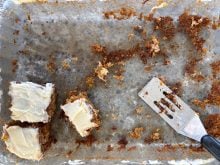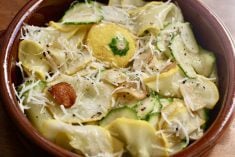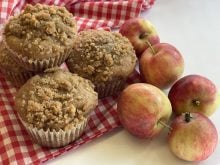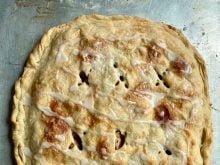Cold winter days make us long for hot-from-the-oven foods.
Often, these foods have special memories attached to them. Maybe we can remember as a child coming into the house on a cold day and smelling the delicious aroma of a favourite casserole, soup or chilli. The aroma of baking bread evokes this food memory for many people.
Enjoying these foods on a cold day warms our body and the memories warm the soul. That could be the definition of comfort foods.
This casserole has those food comfort memories for our daughter-in-law Leanne because it is a dish her mother made.
Read Also

Know what costs are involved in keeping crops in the bin
When you’re looking at full bins and rising calf prices, the human reflex is to hold on and hope for more. That’s not a plan. It’s a bet. Storage has a price tag.
Shipwreck casserole
Yield: Two two-quart (2 L) casseroles, each serves six to eight.
The recipe can be halved to make only one casserole.
- 4 c. potatoes, thinly sliced 1 L
- 2 c. onions, chopped 500 mL
- or
- 2 tbsp. dehydrated onion 30 mL
- 1 1/2 lbs. lean ground beef 750 g
- 2 1/4 c. rice, uncooked 560 mL
- 1 1/2 c. celery, sliced 375 mL
- 1 1/2 c. carrots, sliced 375 mL
- 1 c. frozen peas 250 mL
- 1 tsp. salt 5 mL
- 1/2 tsp. pepper 2 mL
- 2 tsp. beef bouillon powder 10 mL
- 2-796 mL canned tomatoes, with juice
- or
- 2-284 mL canned tomato soup and
- 4-284 mL cans hot water
- 1 c. cheese, grated 250 L
Brown ground beef and drain fat.
Using two two-quart (2 L) casserole dishes, place alternate layers of potatoes, onion, hamburger, uncooked rice, celery, carrots and peas. Season with salt and pepper. Pour tomatoes or tomato soup mixed with water over the ingredients.
Bake covered for 2 1/2 hours in a 350 F (180 C) oven. Uncover for the last half hour, and top with cheese.
Casserole can be frozen unbaked. Wrap in foil and then in a plastic bag.
To bake, place frozen casserole, covered with foil, in a cold oven, turn on oven to 350 F (180 C). Bake three to 3 1/2 hours. Uncover for the last half hour, and top with cheese.
Adapted from: From Prairie Kitchens, recipes by Saskatchewan Women’s Institute, Compiled by Emmie Oddie.
Shredded wheat bread
Shredded wheat was a frequent breakfast food in my childhood home. My father was a grain farmer growing spring wheat, durum wheat and flax. He felt eating shredded wheat was an indirect way to use the wheat that he produced. A little hot water to soften the shredded wheat biscuit, then a drizzle of honey and milk made it a delicious quick breakfast.
My life-long love of shredded wheat prompted me to try this recipe. The bread is light in texture and golden in colour, with a slight molasses flavour. Great for sandwiches or to serve with a casserole or baked beans. Yields: two to three loaves.
- 2 1/4 c. boiling water 560 mL
- 1 c. crushed shredded wheat cereal (three biscuits) 250 mL
- 1/2 c. cooking or fancy molasses 125 mL
- 2 tbsp. shortening 30 mL
- 1 1/2 tsp. salt 7 mL
- 1 – 8 g pkg. quick-rise instant yeast
- 3 tbsp. Bread Booster (optional) 45 mL*
- 5-1/2 to 6-1/2 c. all-purpose flour 1375 – 1625 mL
- Melted butter, optional
Place shredded wheat in large bowl of a mixer with a dough hook, pour boiling water over cereal. Add molasses, shortening and salt. Let stand until mixture cools to 110 F-115 F, stirring occasionally.
To cereal mixture, add three cups flour, yeast and bread booster. Beat until smooth. Mix in enough remaining flour to form a soft, sticky dough. Continue kneading with dough hook until dough is smooth and elastic, about five to six minutes.
To knead by hand, turn the sticky dough onto a floured surface, knead until smooth and elastic, about six to eight minutes.
Cover dough and let rest 10 minutes, dough will not rise.
Divide dough in half. Shape into loaves by rolling under the edges of dough. Place in two greased 9×5-inch loaf pans. If using smaller pans make three loaves. Cover and let rise until doubled, about one hour.
Bake at 375 F for 30-35 minutes or until golden brown. Remove from pans to wire racks. Brush with melted butter if desired. Cool.
*Bread Booster is a new product by Fleischmann’s that can be used with any yeast-based recipe. It contains wheat gluten, inactive yeast, soy lecithin, wheat enzymes and ascorbic acid. The additional gluten strengthens the dough to hold the gas bubbles produced by the yeast, which allows the dough to hold more air and rise higher producing a lighter texture. Additional gluten is useful when using different kinds of flour that may have a lower gluten content. The ascorbic acid (vitamin C) helps to strength the gluten, and the enzymes and ascorbic acid help to activate the yeast to achieve the best rise. The ascorbic acid and soy lecithin are natural preservatives for the bread.
Five-week bran muffins
Having this bran muffin mix in the fridge makes it easy to have hot, fibre-filled muffins for breakfast every day or as an after-school snack. Serve with sliced cheese or yogurt and fresh fruit.
Yields two to three dozen muffins.
Double recipe for a larger batch to store in the refrigerator.
- 3 c. natural wheat bran 750 mL (usually found near the rolled oats)
- 1 c. boiling water 250 mL
- 2 eggs, slightly beaten
- 1/2 c. fancy molasses* 125 mL
- 1/2 c. canola oil 125 mL
- 2 c. buttermilk or sour milk** 500 mL
- 1 c. white sugar 250 mL
- 1/2 tsp. salt 2 mL
- 1 tbsp. baking soda 15 mL
- 2 1/2 c. all-purpose flour 625 mL
- or
- 1 1/4 c. whole wheat flour 310 L and
- 1 1/4 c. all-purposeflour 310 mL
Mix bran with boiling water, stir to moisten evenly. Set aside to cool. Add egg, molasses, oil, and buttermilk. Mix well, add sugar, stir in. Measure dry ingredients into a separate bowl, stir to combine, add to wet ingredients, stir just to combine.
Place in parchment-paper-lined muffin tin or use reusable silicone muffin liners, bake at 350 F (180 C) for 25 to 30 minutes or until a toothpick inserted into a muffin comes out clean.
This batter can be stored in a large glass jar in the refrigerator for five weeks. Bake as needed.
Mark the date batter was prepared on the lid of the jar.
A jar of batter makes a good gift for a new mother. She can quickly bake some fresh muffins when wanted.
For additional flavour and nutrients add one of the following to the muffin batter just before baking. Use one-half to one-quarter these amounts if making smaller batches of muffins.
- 1 c. chopped dates 250 mL
- 1 c. raisins 250 mL
- 1 c. dried cranberries 250 mL
- 1 c. fresh blueberries 250 mL
- 1 c. fresh saskatoon berries 250 mL
- 1/2 c. grated apple 125 mL
- 1/2 grated carrots 125 mL
For both raisins and cranberries pour 1/2 cup of boiling water over the fruit, let sit for five minutes to plump. Drain water and add fruit to muffin batter. The cranberry juice is delicious, reserve to add to fruit juice.
I especially like a combination of cranberries and blueberries in these muffins.
*For a stronger molasses flavour, cooking molasses could be used.
**To make sour milk
- 2 tbsp. vinegar or lemon juice 30 mL
- 2 c. milk 500 ml
Add vinegar or lemon juice to milk and mix well, let sit for two to three minutes. The milk will separate.
Kath’s coleslaw
This recipe is adapted from my daughter Katherine’s recipe. It is a great winter salad that is easy to mix up once partially prepared.
- 1 head green cabbage
- 1-2 carrots (optional)
- 1 1/4 c. mayonnaise 310 mL
- 1/2 c. sugar 125 mL
- 2 1/2 tsp. apple cider vinegar 12 mL
Fresh or frozen dill weed, chopped.
Green onions or chives chopped.
Shred cabbage and carrots using a food processor, red cabbage could also be added.
Let cabbage, drain to reduce the amount of water.
Chop up a large quantity of the cabbage and store in refrigerator for several days in a sealed bag. Purchased precut coleslaw could also be used.
For the dressing stir together the mayonnaise, sugar and vinegar. Store in refrigerator.
To desired amount of chopped vegetables, add just enough dressing to moisten, add dill, onion or chives to flavour. Fresh or frozen blueberries or saskatoons could also be added.
Betty Ann Deobald is a home economist from Rosetown, Sask., and a member of Team Resources. Contact: team@producer.com.















